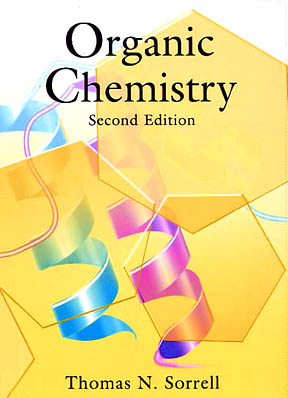
Organic Chemistry, Second Edition
The Second Edition of Organic Chemistry maintains all the innovative features of the first edition in a sleeker, slimmer, and easier-to-navigate design. Hailed by J Chem Ed as “the new wave” in organic textbooks, this book’s mechanistic approach constructs organic chemistry from the ground up.
View Solutions ManualSummary
The Second Edition of Organic Chemistry maintains all the innovative features of the first edition in a sleeker, slimmer, and easier-to-navigate design. Hailed by J Chem Ed as “the new wave” in organic textbooks, this book’s mechanistic approach constructs organic chemistry from the ground up. By focusing on the points of reactivities in organic, this text allows students to approach more and more complex molecules with enhanced understanding. Also noteworthy are the biochemical examples for their variety, substance, and depth. Despite its unique emphasis on reactivity, the book facilitates easy adoption by covering organic compound classes in the traditional order. Hundreds of worked examples and student exercises combine with clear writing and sound pedagogy to make this text an exceptional choice.
What’s New in this Edition?
-
a sleeker, slimmer volume
-
improved organization designed for ease of use
-
more examples and solved exercises
-
fewer specialized topics
-
the first chapter on nucleophilic substitution has been expanded and divided into two chapters, allowing alkyl halides and alcohol substitution reactions to be treated separately
-
oxidation reactions of alcohols have been removed from the chapter on elimination reactions, and a separate chapter on reduction and oxidation reactions has been created (Chapter 11), which also includes discussions about the reduction and oxidation reactions of alkenes
-
the chemistry of dienes, including the Diels-Alder reaction, have been collected in a chapter separate from the one devoted to the addition reactions of simple alkenes
-
the order of topics in the chapters presenting spectroscopic methods has been reversed, so nuclear magnetic resonance spectroscopy is now covered first
-
the chapter that introduces synthetic methods has been largely preserved from the first edition, but it is followed directly by the chapter on enantioselective synthesis
-
the discussion of enantioselective reactions has been completely rewritten, and its emphasis has been changed to encourage students to think about designing enantioselective syntheses without having to memorize a lot of details about specific reagents and conditions
-
the topic of aromatic compounds— benzene and its derivatives—has been moved, and the presentations about diazonium compounds and nucleophilic aromatic substitution reactions, have been incorporated into new Chapter 17
-
the chapter about about aldehydes, ketones, and carbohydrates has been divided into two chapters in the current edition, with the division made according to the reaction mechanisms involved, not according to the functional groups that are undergoing the reactions
-
the chapter on nitrogen-containing compounds has been parceled in this edition among several chapters in the new edition
-
in contrast, the discussions of polymer chemistry, which were interspersed throughout the book in the first edition, have been collected to form Chapter 26 in this edition
Ancillaries
- Students may also purchase accompanying customized online homework from WebAssign.
- Customized online homework is also available from Sapling Learning.
- Art is available for download by adopting professors
Translated into Japanese.
Resources
List of Adoptions
Preface
View PDF File of Complete Frontmatter
Table of Contents
Chapter 1 The Structures of Organic Molecules
Chapter 2 Bonding in Organic Molecules
Chapter 3 The Conformations of Organic Molecules
Chapter 4 The Stereochemistry of Organic Molecules
Chapter 5 Chemical Reactions and Mechanisms
Chapter 6 Substitution Reactions of Alkyl Halides
Chapter 7 Substitution Reactions of Alcohols and Related Compounds
Chapter 8 Elimination Reactions of Alkyl Halides, Alcohols and Related Compounds
Chapter 9 Addition Reactions of Alkenes and Alkynes
Chapter 10 Addition Reactions of Conjugated Dienes
Chapter 11 Oxidation and Reduction Reactions
Chapter 12 Free Radicals: Substitution and Addition Reactions
Chapter 13 Proton and Carbon Nuclear Magnetic Resonance Spectroscopy
Chapter 14 Determining the Structures of Organic Molecules
Chapter 15 Organometallic Reagents and Chemical Synthesis
Chapter 16 Asymmetric Reactions and Synthesis
Chapter 17 The Chemistry of Benzene and Its Derivativesa
Chapter 18 Nucleophilic Addition Reactions of Aldehydes and Ketones
Chapter 19 Addition-Substitution Reactions of Aldehydes and Ketones; The Chemistry of Carbohydrates
Chapter 20 Addition-Elimination Reactions of Aldehydes and Ketones
Chapter 21 Addition-Elimination Reactions of Carboxylic Acids and Derivatives
Chapter 22 The Acid-Base Chemistry of Carbonyl Compounds
Chapter 23 The Nucleophilic Addition Reactions of Enolate Ions
Chapter 24 Conjugate Addition Reactions of Unsaturated Carbonyl Compounds
Chapter 25 The Chemistry of Polycyclic and Heterocyclic Arenes
Chapter 26 Polymers and Polymerization
Chapter 27 Amino acids, Peptides, and Proteins
Chapter 28 Nucleic acids and Molecular Recognition
Reviews
“Sorrell writes well, and has a knack for lucid explanations. He uses excellent examples and well designed exercises to make his points. The sections integrating chapter topics with biochemical examples are the best that I have seen. My students have found his book a pleasure to read.”
-Douglas Dyckes, University of Colorado, Denver
“Student response to the first edition of Sorrell’s Organic Chemistry has been overwhelmingly positive. I expect response to the streamlined second edition to be even better.”
-René Boeré, The University of Lethbridge
“The Second Edition of Sorrell’s Organic Chemistry is working well for our course on organic chemistry with a biological emphasis. It is a great combination of rigor and easy reading.”
-Martin Semmelhack, Princeton University
“Sorrell’s Organic Chemistry is a breath of fresh air. It is a truly distinctive approach to the discipline that emphasizes the mechanistic similarities of processes rather than presenting them in the standard functional group approach.”
-Peter Dibble
“This new edition of Sorrell’s Organic Chemistry is a great contribution to those interested in teaching organic with an eye toward biochemistry. Students very much appreciated the clarity of the writing and pertinent biological examples.”
-Josh Rabinowitz, Princeton University

